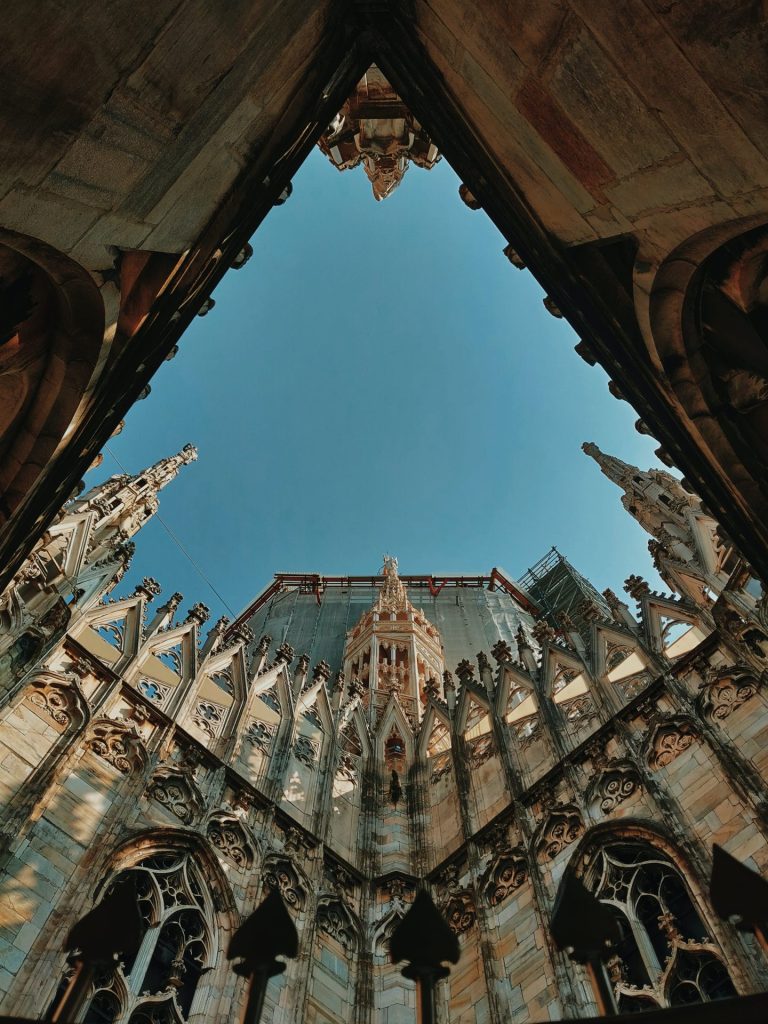Gothic architecture is a style of architecture that emerged in Europe during the late medieval period, around the 12th century, and continued to evolve until the 16th century. It is characterized by its distinctive features, including pointed arches, ribbed vaults, and flying buttresses. Gothic architecture is most commonly associated with cathedrals, churches, and other religious structures but was also used in the construction of civic buildings and universities.

Key characteristics of Gothic architecture include:
- Pointed Arches:
- One of the defining features of Gothic architecture is the use of pointed arches. These arches replaced the rounded arches of the preceding Romanesque style. Pointed arches provide a sense of verticality and allow for the distribution of weight more efficiently.
- Ribbed Vaults:
- Gothic cathedrals often feature ribbed vaults, which are interconnected arched ribs that create a skeletal structure to support the ceiling. This innovation allowed for greater height and openness in the interior spaces.
- Flying Buttresses:
- Gothic buildings frequently incorporate flying buttresses, external arched supports that transfer the lateral thrust of the vaults and arches away from the walls. This architectural innovation allowed for thinner walls and larger windows.
- Gothic Windows:
- Windows in Gothic architecture are often large and intricate, with pointed arches and tracery. The use of stained glass windows became a prominent feature, allowing for the infusion of colored light into the interior spaces.
- Gargoyles and Grotesques:
- Exterior decorations include carved stone figures, such as gargoyles and grotesques, which serve both decorative and functional purposes. Gargoyles often act as water spouts, directing rainwater away from the building.
- Vertical Emphasis:
- Gothic architecture is characterized by a strong vertical emphasis, with buildings designed to draw the eye upward. This verticality symbolizes a connection to the divine and a sense of aspiration.
- Decorative Ornamentation:
- Elaborate ornamentation is a hallmark of Gothic architecture. Buildings are adorned with sculptures, reliefs, and intricate carvings, often depicting biblical narratives, saints, and other religious themes.
- Tracery:
- Tracery is a decorative stone or woodwork that divides and supports the glass in Gothic windows. It comes in various patterns, such as the curvilinear forms of flowing tracery in the later phases of Gothic architecture.
- Pinnacles and Spires:
- Many Gothic structures feature pointed towers, pinnacles, and spires that contribute to the overall verticality of the design. These elements often serve as focal points and add to the grandeur of the building.
- Three-part Elevation:
- Gothic cathedrals typically have a three-part elevation, consisting of the nave, the triforium (a narrow gallery above the arcade), and the clerestory (a row of windows in the upper part of the nave).
Notable examples of Gothic architecture include the Notre-Dame Cathedral in Paris, the Canterbury Cathedral in England, and the Cologne Cathedral in Germany. Gothic architecture reflects the religious and cultural aspirations of the medieval period and represents a significant departure from the earlier Romanesque style. The style has left a lasting impact on European architecture and has inspired revivals in subsequent centuries.

